INTRO:
From Software’s Souls titles practically established a genre of gameplay that the King’s Field games could not. Other developers took a noticeably long time to do their own Souls-like titles, but such
copying was a certain eventuality. After all, From Software has proven that there is a market for such “hard” games.
Lords of the Fallen put little-known Deck13 Interactive in the spotlight. There was both consternation and elation from followers of the Souls formula – the former for there being copy-cats, the latter for there being something other than the Souls titles, which have been criticized for not learning from players’ complaints at the time.
Deck13 did well enough for itself to set some roots as a developer of Souls-like titles, especially after From Software and the publishers of the Souls titles did not raise any fuss. Although Deck13 is probably not the first to do so, Deck13’s story would be one that is repeated elsewhere and in sometimes different forms, such as Ska Studios’ Salt and Sanctuary.
Interestingly, Deck13 would not be doing a sequel to Lords of the Fallen; that project went to another developer, and has since then been in development limbo as it exchanged hands multiple times after.
Thus, Deck13 did the next thing that it could: make another Souls-like, but give it an industrial sci-fi skin. It is not an entirely convincing difference, but it is enough to allay legal problems.
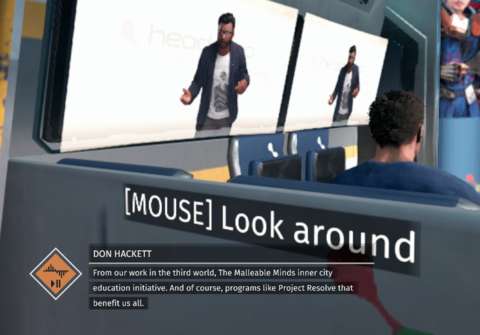
PREMISE:
The game takes place in a sci-fi future where Earth is running out of resources and is feeling the strain of overpopulation.
One of the solutions to this crisis is to fire rockets into space; presumably the payloads of the rockets are something that would somehow be helping the Earth. Wealthy corporations like CREO operate these projects and employ a lot of people who would otherwise have no livelihood.
One of the perks – and occupational hazards – of working with CREO is to have a bionic rig for the purpose of mounting exoskeletons. The rig is practically installed into a person, effectively turning their bodies into company property.
However, the rig also restores mobility to the physically disadvantaged. It so happens that the player character, Warren, is a paraplegic. (This is revealed through a scene with a decently clever camera angle.) He wants a job, and the job that he wants happens to provide a rig that can let him walk again. Of course, in a Souls-like game, this is just a prelude to a dream turning into a nightmare.
Anyway, there were already some signs that all is not well. There are not a lot of people arriving at the CREO facility that he went to, for one.
The most obvious sign though, is that the installation process for the rig was not conducted with application of any sedatives or anaesthetics. Warren loses consciousness, and he wakes up to another living nightmare. His body has been disposed in a junkyard, and some drones are about to forcibly take his rig off. He regains control of his body, and promptly learns to wield improvised industrial tools as weapons.
Plot armour for Warren aside, the story of The Surge would be told through character-to-character dialogue and audio logs. This is not unlike most other video games (including Lords of the Fallen) with storytelling that is at least decently understandable.
On the other hand, this is still much more concise than the storytelling in the Souls series, which have to be read like source-books for table-top RPGs.

GAMEPLAY – OVERVIEW:
As mentioned already, The Surge is a Souls-like title. Combat is methodical and often slow enough to follow with the eye. That said, every hit that lands would inflict considerable damage, so mistakes on anyone’s part would be costly and painful.
A Souls-like typically has the player collecting and hoarding a tangible resource that is far removed from the usual (and easily implemented) experience points. This resource would be used to power-up the player character, or spent on other things, thus requiring the player character to do some balancing in its expenditure. In the case of this game, this resource is given the name “Tech Scrap”.
The player character would be traipsing through places that are populated with dangerous things and hazards. These places happen to have spots that can be considered sanctuaries, i.e. there are noticeably no hostiles or hazards in these spots. The aforementioned places also have paths that eventually round back around to these safe spots, but the paths tend to be blocked initially and have to be opened by reaching the other side of the paths.
Dying causes the player character to drop the aforementioned accumulated resource. The player character is revived at the safe spot, and has to get back to the location where the death occurred in order to retrieve the resource. This is easier said than done; dying again prior to its retrieval causes the resource to be lost.
Dying causes the player character to be somehow revived at the safe spot. This also causes almost all hostiles to respawn. Using the safe spot to recuperate also respawn them. Thus, the only significant progress that the player has in exploring a level is how familiar that the player has become with its layout.
Eventually, the player character would come across particularly powerful and unique enemies that somehow lock the player character into an arena. The player character can only get out of the arena by either dying or defeating these enemies.
So far, so Souls. The Surge does not diverge much from the working formula for Souls-like titles. That said, players that are particularly experienced with the Souls formula might consider this game to be closer to Bloodborne in terms of its gameplay speed, but that is debatable.
AUTO-SAVE:
Another trope about Souls-like games that The Surge perpetuates is their lazily-designed auto-save system. Any playthrough only has one auto-save; better-designed games usually make a back-up, just in case, but The Surge only ever has one for each playthrough. This makes vulnerable to glitches that corrupt game-saves. (Wiser players would make back-ups of the game-saves to compensate for the developers’ negligence, of course.)
The auto-save updates whenever the player character passes through certain locations. The most notable of these is the entrance to any safe spot.
The game also updates the auto-save several seconds after an enemy has been defeated. This is very important to know; resuming a playthrough can be hazardous, if the game updated the auto-save when there are enemies in proximity to the player character.
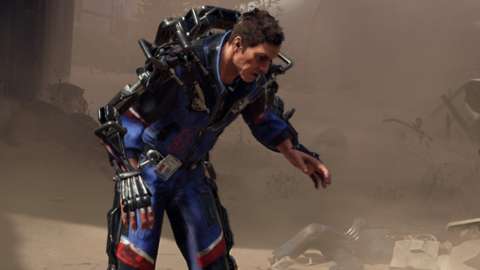
TECH SCRAP:
“Tech scrap” is the equivalent of “souls” in this game.
In the narrative, the human workers in the CREO facility are mainly doing salvage work. The rocket launches leave behind used gantries and rocket sections that cannot be used, but can be scrapped and recycled. Presumably, the materials that can be recovered have enough technological value such that the salvage work is economical. Hence, “tech scrap” can be used to upgrade the player character’s rig and other gear.
That narrative excuse does not explain why tech scrap is mainly obtained from defeated enemies, however, or how it is so quickly gathered, i.e. immediately after the demise of defeated enemies. Of course, The Surge being a game with a sci-fi story, the other narrative excuse is implied to be wondrous nanotechnology.
Some loot are in the form of actual scrap, of course, which makes for more believable collection of Tech Scrap. However, these are practically the equivalents of the souls-invested items that can be destroyed to yield souls in the Souls games.
Expectedly, Tech Scrap is to be spent on either powering up the player character’s core (more on this later), or to craft and upgrade his gear. Typically, further upgrades tend to be costlier.
TECH SCRAP COLLECTION BONUSES:
A pervasive problem with video games that use consumable resources for power progression is that as the costs become greater and greater, the tedium of gathering the resources becomes more and more noticeable. The same issue occurs in The Surge.
However, The Surge does innovate in this matter. This innovation comes in the form of a bonus system that increases the amount of tech scrap that can be looted off defeated enemies later. The magnitude of the bonus depends on the amount of tech scrap that the player has already collected. Therefore, the more tech scrap that the player has, the more tech scrap that the player would get.
This positive feedback loop can result in some exhilaration or heartache, depending on how greedy and careless the player is. Even if the player is not looking to take advantage of this system, this system would reward the player for finding a looping route back to a region’s safe spot, which compounds the satisfaction for having done so.
CORE POWER:
The Surge’s equivalent of player character “levels” is “core power”. This is the capacity of the energy core that is powering the player character’s rig. Getting it higher is one of the player’s prerogatives throughout any playthrough.
On the other hand, core power is not directly representative of the actual power level of the player character. Rather, the latter depends on the player character’s loadout. Instead, core power determines the breadth of said loadout. Many things take up core power, so having more core power means having more options.
This is noticeably different from games that cleave closer to the Souls formula of directly powering-up the player character. This means that if the player wants to power-up the player character, the player needs to progress further in the playthrough in order to come across the opportunities to gain new gear, which are the main source of the player character’s power.
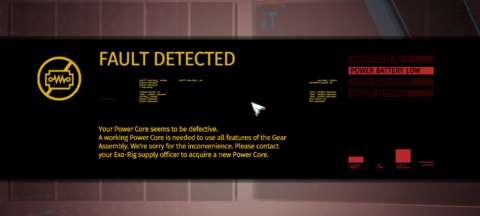
IMPLANT SLOTS:
In addition to the pieces of gear that are mounted on the player character’s rig, there are the implants that are presumably somewhere in Warren’s head, or perhaps somewhere on the rig. The player character’s capacity for implants are shown as slots.
The starting rig has only eight slots, and not all of the slots are available from the get-go. The locked slots are unlocked as core power increases; the power levels required are shown to the player. Later in the playthrough, the player would come across other rigs that increase the number of slots.
There will be more on implants later, after the other basic gameplay elements are described.
HEALTH:
Warren may have an exoskeletal rig, but this does not make him invincible. Much like the player characters of other Souls-like games, Warren can die rather easily, if the player is not being cautious or observant.
There are many ways to regain health, but all of them come with risks or limitations. The most potent and least risky means of doing so is to use instant-healing implants, but these of course take up slots and are rendered useless after the player has exhausted their reservoirs.
The safe spot in every region has a Medical Station. Using the station completely refills Warren’s health and replenishes all injectable devices. Of course, according to the Souls gameplay formula, this will return all vanquished enemies back to life. There is no narrative explanation for this.
(Not that this would be a significant complaint, of course. Most of the Souls games, barring perhaps Bloodborne, have no narrative excuse worked out for this. This is as much a running gag as it is a design trope in Souls-like games.)
In the second region and the others later, there is at least one wall-mounted machine that can refill Warren’s health and injectable devices, just like the Medical Station would. However, enemies do not respawn. On the other hand, the machine is used up afterwards and will only be replenished after using the Medical Station.
There are some implants that let the player character heal while attacking or finishing off enemies. These are risky, but they are there for players who are familiar with the combat and are confident in their abilities.
STAMINA:
As is typical of a Souls-like title, there is a stamina meter that prevents the player character from simply making one attack after another. This is despite the assistance that should have been provided by Warren’s exoskeleton. (The narrative excuse for this is that the rigs were not designed for rigorous combat in the first place.)
Every attack consumes stamina. More strenuous attacks, like pouncing forward, consume more. Running out of stamina causes delays in Warren’s attacks. Having stamina exhausted also prevents Warren from dodging. It also makes him visibly tired, which in turn makes him more vulnerable to losing his stability after being attacked. (There will be more on ‘stability’ later.) Thus, as in any other typical Souls-like title, the player has to be careful about not over-reaching.
That said, Warren can still run around without expending any Stamina. Sprinting will cost stamina, but his default running speed is already considerable.
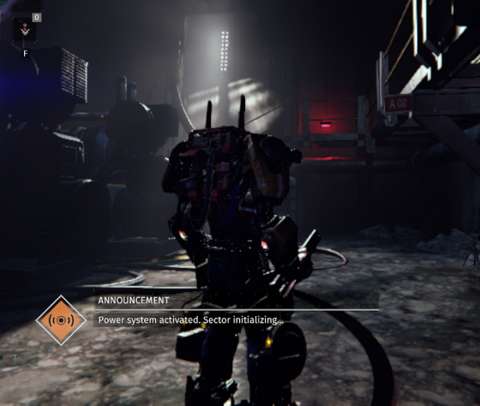
STABILITY:
This is The Surge’s take on the mechanism of “Poise” in the Souls titles. Every character has a stability meter, including Warren. This meter is hidden by default, but there is an implant that can reveal the meters of enemies. (Warren’s remains hidden, however.)
Stability is reduced through making strenuous attacks, and taking hits from attacks. When the stability meter of a character depletes completely, bad things happen to that character.
In the case of humanoids, the character either staggers or kneels down. Any hard hit will knock this character to the ground, sprawling. Any hits suffered when he is staggered, kneeling or lying down on the ground inflicts greater damage, and may even delay recovery. If this happens to Warren, death usually comes after.
In the case of non-humanoids, i.e. machines, they usually appear paralyzed, or they slump onto the ground. The effect is the same: they take greater damage.
Stability eventually self-replenishes, but only after a few seconds of not being under an onslaught of attacks.
ARMOR:
Among the pieces of gear that the player character can have, the pieces of armor that are slapped onto Warren’s exoskeleton are the least interesting. This is despite their varied looks.
On their own, most of these armor pieces merely alter Warren’s statistics. They do not unlock any additional functionalities, at least not at first glance and especially if the player has been mixing and matching.
However, observant players who switch out gear pieces a lot may notice some subtle benefits. For example, fully enclosing headgear renders Warren immune to toxic gases.
FULL ARMOR SET BONUSES:
The benefits of armor pieces become visible when the player character does don all of the armor pieces of the same set. Still, these benefits can seem situational, or dependent on some other factors.
For example, wearing a full set of LYNX armor increases Warren’s attack speed for any weapon, but this benefit is only active when he is at full or near-full health. Having attack speeds that change during battle can be off-putting, considering that reliable timing is key to combat.
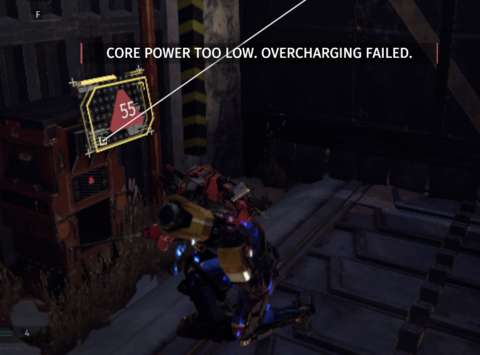
IMPLANTS – OVERVIEW:
Implants are the main means of tricking out the player character. To cite another Souls-like game, the gameplay system of implants is similar to that of the runes in Bloodborne.
These implants determine the capabilities of the player character, because there are many types of implants. Most can only be installed or switched out at the Medical Station.
The first one that the player would come across are injectable devices, which impart benefits when they are used. Injectable devices have limited uses, and generally can only be replenished at the Medical Station or through finite means that will be described shortly.
Later, the player will come across implants that are “hardwired”. Like injectable devices, these cannot be replaced so easily. These implants generally bolster the energy gains from attacks (more on these later), or let the player regain health from attacking or finishing off enemies.
Then, there are hot-swap implants. As their names suggest, the player can have these swapped out for other hot-swap implants. These implants have very situational benefits, more so than the others, so it is fortunate that they can be readily changed.
Certain implants will be described shortly, because of their significance to the gameplay.
OCCASIONAL INJECTABLE REFILLS:
Generally, injectable implants have reservoirs that can only be refilled at the Medical Station. However, there is a mechanism that is meant to help new players.
This mechanism refills one unit of usage for every injectable implant that the player character has, when he has accumulated enough tech scrap to increase the power level of his core. The progress to this occurrence can be tracked through a meter on the lower right of the screen; the meter resembles a typical experience point meter. When the meter is full, a refill happens.
In the beginning segments of the game, the player would be regaining refills in this manner, thus easing the player into the game. As the playthrough progresses, increments to core power would extend the threshold of the aforementioned meter, thus making these refills increasingly rarer. Of course, by then, the player should be compensating for this with his/her increasing familiarity and skill with the gameplay.
AUDITS:
By default, the health bars of any non-boss enemy are not shown at all. This can be problematic. The player gains the Medical Audit implant early on, which is intended to show these. This is eventually superseded by the Omni-Audit, which shows health bars and stability meters.
Either implant takes up a slot that could have gone to other implants. However, being able to see the health and stability of enemies is a vital aid, especially for players who are meticulous.
LOOT PROXIMITY SENSOR:
Early in the playthrough, the player would come across an implant that emits beeps when the player character is near any collectibles. This is useful for exploring a region for the first time, because being a typical Souls-like game, The Surge has places with nooks and crannies that hide goodies, albeit of variable value.
The sensor will not show the value of these loots, and will not inform the new player of how troublesome they are to get. Still, there are certain implants or weapons that cannot be obtained through any other way, so the proximity sensor will be useful for the new or returning player.
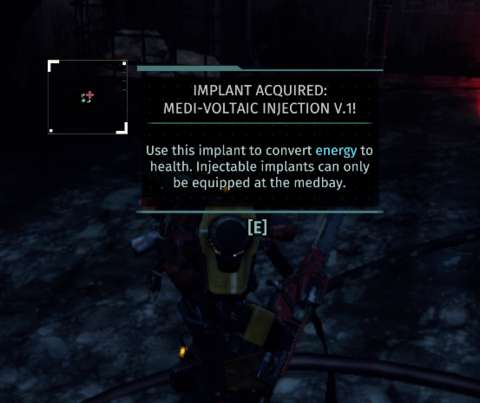
“ENERGY”:
For whatever reason, the core of Warren’s rig cannot produce and keep surplus energy for use in combat. Rather, for the purpose of having surplus energy to use in combat, there is the “Energy” meter and its associated mechanism.
Somehow, as the player character hits enemies, he generates some energy through piezo-electrical means. This energy is stored in his rig initially, but eventually dissipates. Therefore, this energy should be spent on any of the combat-related tactical options that will be described later.
Sometimes, certain enemies, or parts of enemies (especially robotic ones), yield a lot of energy when they are destroyed. At this time of writing, it is still unclear to me how this occurs, though certain specific enemies like the Firebug boss have reliably predictable occurrences like these. Anyway, this completely fills Warren’s energy meter, which can allow for just about any option.
MEDI-VOLTAIC INJECTORS:
The Medi-Voltaic Injector series are implants that consume energy in order to heal Warren. The amount of healing is not generous though. In fact, it is far lower than that from the reservoir-based ones. Furthermore, there appear to be restrictions on when it can be used. For example, the injectors cannot be used whenever Warren is in an attack animation.
THE DRONE:
A drone is a tool that Warren gets when entering the second region. This is a mandatory scene, so it cannot be missed out on.
Warren’s drone resides somewhere in his rig; it disappears and reappears close to the torso portion of his rig. Unlike the drones that are hostile to Warren, it is practically indestructible.
Moreover, when it is deployed, it has its own collision hitbox. It can be used to put an obstacle in the way of enemies, especially the large ones. Their movement, and any attack animations that have them moving, would be blocked by the drone, if the player placed Warren behind it. The enemies also ignore the presence of the drone, which make this peculiarity even easier to exploit.
That said though, the main reason to have the drone around is to make use of its capabilities. Its capabilities depend on the module that it is equipped.
The drone generally requires energy to be activated. The amount of energy to activate it may differ according to the module that it has.
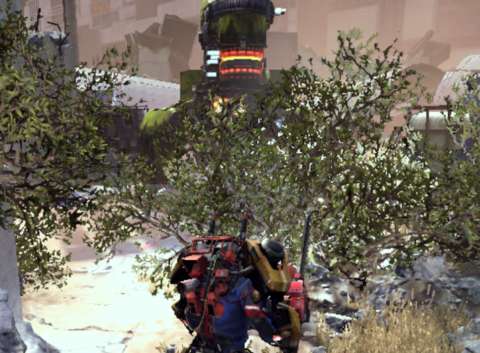
SHOOTY MODULE:
The first module that the player gets is one that lets the drone shoot at enemies. Unlike the other module, this one does not need energy to be activated. However, if it is activated without enough energy, it fires a couple of low-power shots; these are more useful for drawing the attention of hostile enemies from afar.
With enough energy, the drone fires much more powerful shots instead. These are practically Warren’s most reliable form of ranged attacks, mainly because his drone is making ranged attacks instead of him.
Unfortunately, there appears to be a problem with the targeting algorithm of the drone. The drone’s shots might not land on the hitboxes of the target, and can miss entirely. This occurrence is especially noticeable when targeting robotic enemies.
MELEE & PULLING MODULES:
With the melee module, the drone charges at the target, inflicting some damage but more importantly, significantly depleting the stability of the target. For most non-boss enemies, this results in them being knocked down, which renders them vulnerable to the player character’s attacks.
The pulling module gives the drone a sci-fi tractor-beam device to yank enemies closer to Warren. This is usually not desirable, but there are certain enemies that are better off dealt with in melee, such as drones that rely on guns to make attacks.
AREA EFFECT MODULES:
Modules that give the drone area-effect implements come later in the game – which is just as well, because these will be handy for crowd-control.
The flamethrower module is the most expensive to activate. Some players might consider it to be not entirely economical. However, the drone’s attack counts as elemental damage, which can be effective against enemies that do not have much protection against this kind of damage. Incidentally, such enemies tend to be found in groups, which make them vulnerable to the flamethrower.
The coolant module has the drone spewing liquid nitrogen around. Somehow, this does not seem to affect Warren, but any enemies caught in the vapours are slowed down, which can be advantageous.
TARGETING DIFFERENT BODY PARTS – OVERVIEW:
One of the significant differences that this game has from other Souls-like titles is the ability to target different parts of an enemy. Most enemies are large enough to have discrete body parts; there is a control input to cycle through these parts when the player locks onto an enemy.
When Warren attacks, his attacks are generally directed towards that body part. If the body part is obscured by other body parts, Warren will be hitting these instead. Therefore, the player will still need to make sure that Warren is facing the correct side of the target’s body.
The main reason to attack specific body parts is to weaken them for one of several purposes, which are as follows.
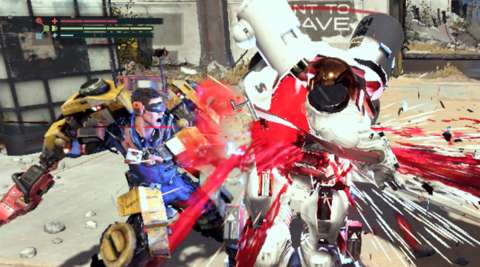
KNOCKING OFF ROBOT PARTS:
Most robotic enemies that are bigger than aerial drones have ancillary parts that can be targeted. These parts have their own health meters, though damaging them also reduces their main health meters (but not by much). After these parts lose their health, they are broken, thus diminishing the offensive power of the robots. Generally, the robots cannot replace these parts.
Destroying these parts also changes their attack patterns, usually to more predictable and manageable ones. For example, after having their sensor arms removed, maintenance robots can only attack by ramming their bodies into the player character; these are attacks that are well telegraphed and should be easy to avoid.
CANCELLING ATTACKS:
Some robotic enemies – especially the very large ones – have body parts that can be separately targeted, but they do not have health meters of their own, meaning that they cannot be knocked off. Rather, the player has these targeted so that attacks that land on them have a chance of cancelling whatever attack that is being executed with the body parts.
The player’s attacks must be hard-hitting enough for the cancelling to happen, however. Otherwise, the attack happens anyway with the player character very much being in its path.
FINISHING MOVES FOR DECAPITATION AND AMPUTATION:
For better or worse, a significant portion of the gameplay involves removing parts from the bodies of enemies – specifically humanoid ones. The game certainly earns its “mature” age ratings.
Anyway, the bodies of humanoid enemies appear to ignite and burn away after they have been defeated. In order to salvage anything from them, parts of their body have to be cut off prior to their demise. Incidentally and perhaps understandably, the trauma from these occurrences would kill said enemies. Thus, these actions are known as “finishing moves”.
As their name suggests, Warren cannot readily perform these finishing moves. There are several conditions for this to happen.
The first condition is that the body part that is being targeted needs to be considerably damaged. For this purpose, that body part has its own health meter, albeit it is hidden to the player.
The second condition is that Warren must have enough energy for the finishing move; there is no clear or acceptable narrative explanation for why this is needed.
The third condition is perhaps the haziest, because there are multiple variants of this condition, depending on how the enemy was savaged. For this article, these would be referred to as “alternatives”.
The first alternative for this condition is that the enemy needs to have been sufficiently weakened, i.e. its health bar considerably reduced. The second alternative is that the enemy is knocked down; this can lead to an early finishing move.
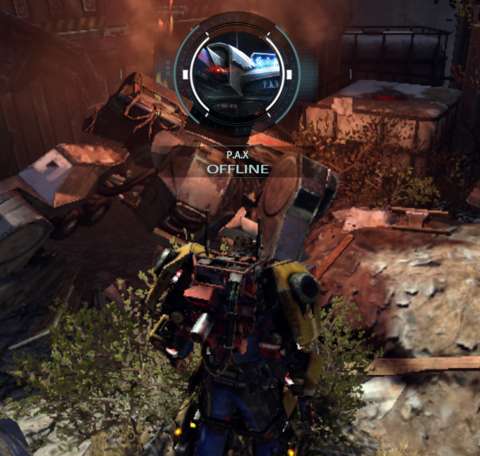
SALVAGING & CRAFTING PARTS:
Cutting off parts from humanoid enemies with finishing moves yields whatever piece of gear that was on these parts. The piece of gear is damaged, but thanks to the advanced technology in the sci-fi setting, this can be reverse-engineered and reproduced by the nanotech forges at the safe spots.
Of course, Warren still needs to find the materials to produce these parts. This means having to cut off more body parts again, likely from the same kinds of enemies. This is among the most tedious portions of the gameplay.
NEED TO HOLD DOWN CONTROL INPUT FOR FINISHING MOVES:
All that have been described about the mechanism of cutting off parts for salvage would have been manageable and acceptable – if not for an unwise design decision.
When finishing moves become available, a prompt appears on the enemy that is being targeted. The player has to hold down the control input for finishing moves.
On the mouse and keyboard set-up, the control input for finishing moves is not used for anything else other than finishing moves during combat. The same control input is used for picking things up and interacting with objects in the environment, but it is unlikely that the player would want to do these during combat.
Meanwhile, the player has to have Warren stay close to the target, while trying to avoid getting hit. Getting too far away breaks the prompt, and getting hit breaks the prompt too. This is frustratingly burdensome; an instantaneous response would have been more suitable.
WEAPONS:
Warren will not be going anywhere if he is not armed. Indeed, he realizes this early on, having quickly armed himself with an improvised weapon to fend off some hostile drones.
Almost all of the weapons are industrial implements that have been turned to violent purposes. There are some weapons that are meant for riot control, but these have been repurposed too. Only a few weapons have been specifically designed for combat, thus suggesting that the prevalence of exoskeleton rigs have made melee combat viable.
Some weapons can be found lying about as free loot. Most others have to be obtained by cutting off the weapon-arms of humanoid enemies; in the case of double-rigged weapons, either arm suffices. Peculiarly, the weapons are not wrecked, but are instead added to the player character’s inventory immediately.
Weapons can be typified into several categories, mainly according to how Warren wields them.
ONE-HANDED WEAPONS:
Warren wields these in his right hand. These are generally the most balanced of weapons, having decent performance in terms of animation speed, hitbox sizes and damage output. Incidentally, one-handed weapons tend to have animation sequences that can be cancelled out of shortly after they start.
DOUBLE-RIGGED WEAPONS:
Double-rigged weapons are mounted on both arms of the exoskeleton. Despite their bulky appearance, they are practically the functional equivalents of dual-wielded weapons in other Souls-like games.
This means that double-rigged weapons have fast attack animations. However, they tend to be chained together, resulting in long sequences that cannot be cancelled out of with a dodge.
Double-rigged weapons have low damage per hit, as to be expected from equivalents of dual-wielded weapons. However, due to the aforementioned attack sequences, their effect on the stability of the target is considerable if all of the attacks land.
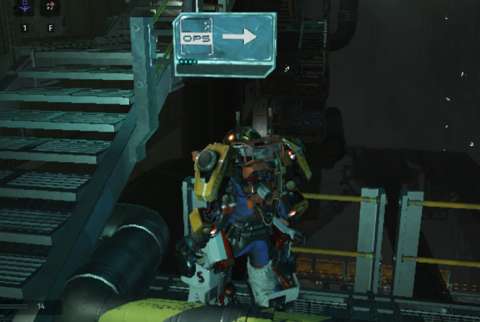
SINGLE-RIGGED WEAPONS:
Single-rigged weapons are powerful weapons that are mounted on one arm. Single-rigged weapons tend to hit hard due to their considerable size and weight. However, being mounted on only one arm meant that the weapons are unwieldy. Thus, single-rigged weapons have slow attack animations, which are not easy to cancel out of.
The main advantage of single-rigged weapons is their massive hit to the stability of the target. A pouncing attack with such weapons tend to stagger most enemies.
HEAVY-DUTY WEAPONS:
Heavy-duty weapons are the equivalents of the two-handed weapons in most other games that have melee combat. Thus, they are typically slow and hard-hitting weapons.
There is seemingly little difference between them and single-rigged weapons. However, being weapons with handles, some of their attacks also have longer reach than the equivalents of single-rigged weapons.
STAVES:
Staves are usually riot control weapons, but the sci-fi industrial setting meant that some staves are practically pipes or conduits that have been pried out from walls.
Staves are two-handed, but are quick to use and have long reach. However, staves do not hit as hard as heavy-duty weapons.
PROFICIENCY SCALING:
Generally, the damage output of the player character depends on his equipped gear and implants. However, some of his own skill does matter; this comes in the form of the mechanism of proficiency scaling.
Weapon proficiencies would be described first. As Warren defeats more enemies with his weapons, his familiarity with the categories of these weapons increases. This is not unlike the system that is utilized in the Elder Scrolls games.
However, simply raising proficiency levels does not outright increase Warren’s damage output. Rather, the weapon that he is using has a “proficiency scaling” statistic, which determines how much it benefits from Warren’s proficiency with its category of weapons.
Generally, weapons with “low” scaling has higher base damage output to compensate, or has special attacks that increase their versatility. Weapons with “high” scaling benefit from the effort of players that spend time to grind their player characters; typically their Warren would have higher proficiencies than that of players who do not do so.

NOTICEABLY DIFFERENT MOVE-SETS:
Although the weapons follow overarching categories, their move-sets can be different. The first stroke that any weapon in the same category makes happen to be similar to the first stroke of the other weapons. However, the subsequent strikes in a chained sequence of attacks can be quite different from weapon to weapon. The damage outputs and stability reductions from these subsequent strikes can be varied too.
This means that the player will want to experiment with these weapons if he/she wants to know what each can do with their combo chains. On the other hand, players who employ hit-and-run tactics might not bother with these.
BLOCKING AND COUNTERING:
Another trope of Souls-like games is a “parrying” system of sorts, which rewards good reflexes and timing but comes with considerable risks. The Surge has its own.
Warren can block, but timing blocks is not important. Rather, in his blocking stance, he can switch to one of two evasive manoeuvres in a near-instant: either a hop, or a duck. The hop evades below-the-waist attacks, whereas the duck evades above-the-waist ones. It is up to the player to learn the hard way which attack is which.
A successfully timed evasion is immediately followed up with an attack that does little damage, but reduces the stability of the enemy considerably. Follow-up regular attacks are more than likely to stagger or knock down the enemy.
UPGRADING GEAR:
Conveniently, the medical stations are next to nanotech forges, so the player can indulge in some crafting after healing Warren and investing any Tech Scrap into core power.
Gear upgrades require Tech Scrap, and in increasing amounts as the gear pieces become more powerful. Furthermore, they require specialized materials of increasingly greater quality.
These materials are categorized according to the types of items that they are made from. For example, all weapons are made from Tungsten Alloys, starting with the Mk. I variant for crafting them into existence. Higher marks of alloys are needed for further upgrades.
GETTING MATERIALS:
Incidentally, materials are obtained from cutting off more parts from defeated enemies. When the parts are returned to the nanotech forge, they are recycled into the materials. The marks of the materials depend on the power levels of the enemies. Typically, enemies that appear later give parts that are recycled into materials of higher marks. Therefore, if the player wants to upgrade Warren’s gear, he/she has to advance further into the playthrough.
ENVIRONMENTAL HAZARDS - OVERVIEW:
CREO’s holdings have seen better days. Due to the workforce being rendered mostly violently insane and its automated systems having gone haywire, they are crumbling down. The consequence of this is that there are environmental hazards all over. These will be described in their own sections.
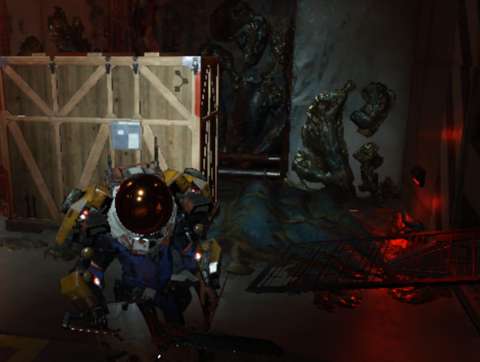
GRAVITY KILLS:
The most pervasive hazard is the fall hazard. Not unlike most other Souls-like titles, gravity has an unpleasant effect on characters that fall off ledges and platforms. Enemies that die from falls do not appear to give their tech scraps to the player character. Furthermore, if the enemies drop items, they drop them where they fell.
If any character falls into a bottomless pit, the character dies and disappears. In case of enemies, they do not leave any loot behind.
INSTANT-DEATH ZONES:
Some fall hazards are further upgraded into places that immediately inflict instant death. These can be places that Warren should be able to seemingly reach, like a drainage channel that is no longer being used. However, as soon as Warren lands on them, he dies. Generally, as a rule of thumb, if someplace looks like it is reachable but otherwise leads nowhere visible, it is likely an instant-death zone.
TOXIC CHEMICALS:
Some places, especially the Resolve Bio-labs, have spills of toxic chemicals seeping about. The chemicals are sticky, caustic and persist.
These spills do not harm any machines and any former human that has full Liquidator or Hazard gear. Incidentally, there are often zombie workers that have these gear sets and that happen to be near these hazards.
Anyone else that gets onto the chemical spills begin to take damage. The damage ramps up the longer that the person stays on the spills.
TOXIC VAPOURS:
Toxic vapours sometimes billow off toxic chemical spills, further compounding their danger. Some enemies, such as the Hazard teams, can fire grenades that release these vapours.
Toxic vapours otherwise work a lot like spills; characters that are vulnerable and that get in them get damaged. Interestingly, if Warren has a head-piece that is fully enclosed, such as the Liquidator head-piece, he is immune to the vapours.
However, that does not mean that the danger from the vapours is neutralized with a fully enclosed helmet. The vapours happen to be flammable; if they come into contact with any flames (excepting those from fiery weapons that Warren is using), they ignite and torch anyone caught in them.
ENEMIES – OVERVIEW:
The enemies are mostly “former humans”, to cite a phrase from the classic Doom titles. They still move like humans would (or to be more precise, humans with sci-fi exoskeletons), but they are otherwise living drones now. The enemies also include robots and multi-articulated industrial machinery, which go about doing their functions until they come across someone like Warren. The reason for their hostility towards Warren and other humans who still have their own minds is revealed later.
Anyway observant players might notice that the more numerous enemies can be lumped into several categories, mainly due to their behaviours and animations in combat. These behaviours and animations are consistent regardless of their loadout.

ZOMBIE HUMANS:
The calamity that savaged the minds of CREO’s human workforce was inflicted with varying degrees of severity. The workers who suffered the worst have their minds savaged to the point that they are little more than corpses being animated by their rigs. However, since the operation of their rigs still depend on their users being in control of their physical faculties, their capacity for combat is severely diminished. Thus, they shuffle about and swing their weapons clumsily.
Consequently, these are the easiest enemies to fight. The later ones have more hitpoints and harder-hitting gear, but their skills are at the same lows. It is a careless player indeed that would lose to the likes of them.
FLYING DRONES:
There are flying drones throughout the game. These are easily thrashed, but they are flying things that can move over places where Warren cannot reach with ease or without being harmed.
As for what they do, the melee ones try to charge Warren and stick their cutting tools into him. This is a much-telegraphed attack that should not be difficult for experienced players to avoid.
The other drones are armed with guns. They may either fire a barrage of shots, or fire a couple of powerful ones. Both are telegraphed with obvious laser beams.
There are more exotic drones later in the game, such as bomb-loaded ones that are just there to be explosive hazards.
ENRAGED HUMANS:
If the affected workers are not reduced to gurgling zombies, they are afflicted with rage at anyone that still have their minds. These move a lot faster than the zombie ones, especially those that are armed with dual-rigged weapons.
The most common ones have heavy-duty weapons, usually the Titanhammers. Unlike the Titanhammer that Warren can use, theirs can be integrated with workplace devices such that they turn into turrets that can fire plasma shots. Incidentally, some of these enemies happen to hang out close to such devices. They will run over to the devices to use them at the first sign of trouble.
The dual-rigged ones are fewer in number, but they are much more aggressive and always begin their attack with a pell-mell sprint. They have no tricks other than going on the assault, however.
The rarest – and most troublesome – of these enemies are those that wield one-handed weapons. These have the fastest animations, and have the greatest tendency to cancel out of these animations with dodges. Due to their rarity, learning to be familiar with their move-sets is not as easy as doing the same with other enemies.

INDUSTRIAL MACHINES:
The presence of industrial machines is usually obvious: they are busy doing some work, like welding things. Their backs are often turned to the player while they are working, so the player character can walk up to them and land some opening blows. Moreover, if the player can have Warren run away far enough, they return to their routines. This means that hit and run tactics work against them.
However, industrial machines are often heavily armored; their armoured locations are often indicated with plates of alloy. Hitting these locations does next to nothing. Furthermore, industrial machines tend to have a lot of hit points.
Perhaps with the intention of scaring or otherwise amusing players, there are industrial machines that lurk behind walls of crates, just waiting to charge through them to a musical cue. If the player keeps an ear out for their tell-tale hum, the player should not be caught unawares.
SMELTER ROBOTS:
Smelter robots are massive machines. They are usually minding their own business, typically smelting things in range. Gameplay-wise, they serve as optional bosses.
They are slow, but their arenas are smalls and they have a lot of sweeping attacks. The attacks that are not sweeping inflict enough to outright kill Warren if they connect, at least at the point of the playthrough where they are encountered.
They have very short pursuit ranges, however, so it is possible to retreat and wait for them to return to their routine. However, if the player character retreats too far, their health bars reset.
Smelters have weak spots, which are at their sides. However, these spots only become vulnerable when they are engaged in combat, and only when their armoured flaps are raised. Beginning a fight by hitting these spots even when their flaps are open does nothing much; the scripting for the weak spots does not become active until after the combat music begins.
Smelter robots do not respawn, and they will remain hazards wherever they are until they are defeated. Thus, there is an incentive to eliminate them. The other incentive is that they drop coins that are used to unlock a certain set of silly armour.
SECURITY GUARDS:
At first glance, the security guards appear to be still human; they do not outright attack Warren when they see him, at least not in the earlier parts of a playthrough.
Non-hostile ones can be provoked into a fight, but this is unwise without considerable preparation; they hit very hard. Where they are first encountered (discounting the prologue), they often overmatch Warren in terms of raw capability.
Still, every enemy in this game is designed to be defeated. It would not take long for observant players to notice that they have a tendency to make unnecessary flourishes with their riot staves; these flourishes do not have any attack hitboxes. These are the best moments to hit them.
If Warren is overwhelming them, cornered security guards will perform an acrobatic flip by using Warren as a leverage. This does not hurt Warren, but greatly reduces his stamina and stability as well as staggering him for a moment. Still, there is a telegraphing motion for this, so the player can avoid having Warren being staggered.
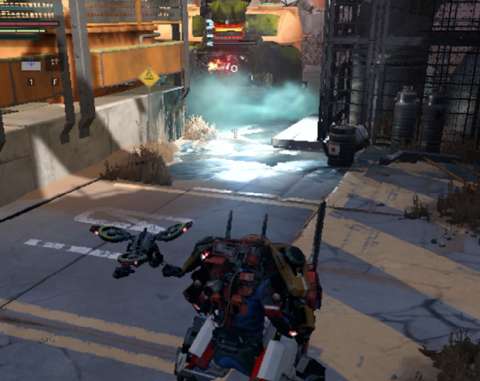
Their behaviours are mostly observable, but there is still an unpredictable element about them. This happens to be their left arm. If this part is armored, this shoulder of theirs will have a built-in laser gun that they can fire without any telegraphing. They can even fire this on the move. This is perhaps the most troublesome that the game could get when it comes to the random generation of equipped armor on enemies, at least in the first playthrough.
Security guards may appear in pairs. These are scripted to come to each other’s aid if either happens to be hurt, meaning that the player may have to face two of them. Wilier players would employ hit-and-run tactics, aiming to kill one and leaving the other for a later fight, preferably one that ends with a finishing move.
BLOODHOUNDS:
Bloodhounds are the robots that CREO’s security forces use. These are large but nimble robots. They have three signature moves. One of these is a backflip that can hit anything that is in front of them; this is the most bothersome of the moves, because it has a short telegraph and makes fighting them head-on too risky for cautious playstyles.
The other two signature moves are often telegraphed with a unique audio clip. One of these has it swinging its tail around, hitting anything around it. The other attack is much more dangerous: it is a long-range pounce that has large hitboxes and can inflict a lot of damage. In addition, a Bloodhound can stab with its tail, after a very short telegraph.
The tail-based attacks can be prevented by knocking off its tail; the player is also rewarded with an implant that can be farmed repeatedly. The Bloodhound’s move-set is thereafter severely curtailed (pun not intended), though it would resort to pouncing a lot more often.
There are two variants of Bloodhounds. The more common of these are Bloodhounds that are supposed to be decommissioned; these do not have as much health as the other, obviously.
The other variant has better structural fortitude, so it has more health and stability. They also have an additional attack with their tails: an electrical current that somehow travels along the ground. If Warren is hit, he is momentarily stunned, which usually means that he is imminently dead.
This other variant is also often together with security guards, which compound the trouble that they pose. Wise players would learn to lure over one or two from any security posse.
EXOTIC ENEMIES:
After the main conceit of the story has been revealed, enemies of clearly and exotically sci-fi nature begin to appear.
The first type of these fight like human enemies, but their inhuman capabilities become clear after they go down for the first time. They come back, faster and fiercer than before, and will relentlessly pursue Warren. This is just as well, because they are rapidly degenerating and will soon die. Daring players would want to take the risk of cutting off more body parts.
The second kind of exotic enemies are clearly no longer human, and not of sanely industrial artifice either. These ones have attacks that can be troublesome, but they have obvious telegraphs that the player would learn to notice sooner or later.
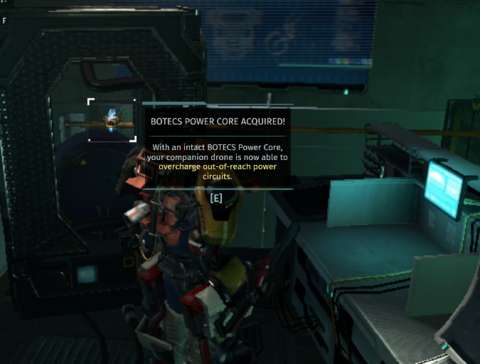
PREVIOUS PLACES RE-POPULATED WITH ENEMIES AS STORY ADVANCES:
As the story advances, things turn from bad to worse. These changes are reflected in the gameplay through the appearance of enemies where there were none before, or the replacement of certain enemies with others.
For example, a security posse appears at the arrival station of CREO’s industrial complex (which is the second region) after Warren has made contact with a certain former scientist. This posse can be unpleasant to players that had not been paying attention to the warnings over the complex’s automated speaker system. (That the posse is waiting in ambush makes this experience worse.)
This makes backtracking a tad dangerous. However, they also open up opportunities to farm enemies for parts.
CONTENT DLC & NEW ENEMIES:
There had been two significant expansions for the game, and these are priced. However, there were also content packs for the game that were and still are free.
Interestingly, these make use of existing spaces in the main game. Enemies that were not there before happen to be in these places, wielding weapons and gear that are introduced in the content updates.
Of course, the player needs to put effort into getting them. More often than not, these enemies would be unpleasant surprises to players who are new to them; they are using the move-sets that these weapons provide. Some of their placements might also be unpleasant, such as one of them being rather close to an optional mini-boss.
NEW GAME PLUS ENEMIES:
New Game Plus mode, i.e. playthroughs made using a Warren that has completed an earlier playthrough, introduces new enemies.
Some places may have more enemies, and more variety in their composition. This means that experienced players will want to be cautious, even when traipsing through locales that would already be very familiar.
The most significant of the additional enemies are the so-called ‘patchwork’ enemies. They are called so because they have gear that are randomly generated. Their move-sets are dependent on the types of weapons that they use. Generally, they are faster and fiercer than other former humans.
RESPAWNING ENEMIES:
As to be expected of a Souls-like title, most enemies respawn when the player character dies and returns to the Medical Station, or returns to the Medical Station to heal. There are some that will not respawn, like the aforementioned Smelter Robots and any security posses that happen to be outside of security-only locales.
Most enemies respawn at their exact locations and will follow whatever patrol routine that they have. However, they may change their locations and patrol routines slightly, if the player has opened this or that pathway.
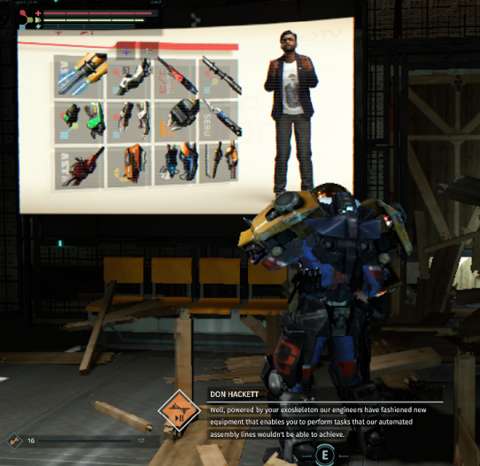
PROBLEM WITH ENEMIES RESPAWNING WHEN CONTINUING GAME-SAVES:
Unfortunately, likely due to a design oversight on the part of the developers, the region that is Resolve Biolabs happens to have a problem about its respawning hostiles.
In the other regions, game-save reloads take into account the enemies that have been defeated prior to the next death or use of the Medical Station. Therefore, if the player resumes a playthrough in a location that has been cleared of hostiles, there would not be any that accosts the player character. This is not the case in Resolve Biolabs.
It is possible for the unsuspecting player to resume a playthrough while progressing through the Resolve Biolabs, only to have Warren mobbed by enemies that the player remembered having defeated earlier. This can be very unpleasant to learn the hard way.
That said, this complaint had been raised back in 2017. A Steam forum thread about this problem is still around and has not been responded to by any of the developers.
BACKTRACKING:
There are places with paths that are inaccessible to Warren. Some of these cannot be opened by going around them and opening them from the other side; the clearance of these obstacles happens to be story-advancing milestones. Usually, Warren can only open them after gaining something that has significance to the narrative.
For example, there is the replacement for the power core of his rig, which occurs early in the playthrough. Without a replacement, Warren cannot overcharge certain conduits with his rig’s power core and thus gain further access into the CREO complex.
This means that the player would be backtracking once in a while, usually after the player has been reminded of goodies that have yet to be found or places that Warren should return to in order to progress further.
These are moments when the player can gauge how far Warren has come. Being able to one-hit enemies that appeared earlier can be satisfying. However, as mentioned earlier, new enemies appear too, and these can be nasty surprises if the player assumed that these previous places have remained the same.
VISUAL DESIGNS:
Lords of the Fallen was a game that really pushed the hardware of its time, and The Surge is not any different. Thusly, the game needs considerable computing power, like that suggested by the official “recommended” specifications.
That said, for the computer version of the game, if the player’s rig could meet these specs, there are many, many polygons to be seen in the models of this game. Even though the sci-fi, robotics-laden setting means that there would be technology with hard angles and such, the developers have managed to pack many sub-polygons into these. There are detailed textures and complex lighting too.
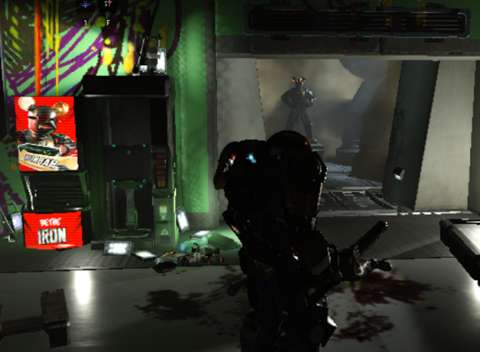
Unfortunately, the minimum requirements are a half-truth that had been made only with minimal testing. The game’s display will freeze whenever the GPU that just meets the minimum is significantly loaded. That said, there had been players with higher-end rigs that had been meeting such problems too. (Thus far, I have yet to find any solution to this problem.)
Still, even at the lowest settings, the player can observe the extensiveness of industrialization in the CREO complex. There are also outdoors sections in the CREO complex, such as those at Abandoned Production, which shows a glimpse of the current state of the world in this game.
Most importantly, The Surge has visuals that give the impression that it is set in a bleak and oppressive world – just like all other Souls-like titles.
Most of the animations that the player would see can be attributed to machinery, be they the exoskeletons of rigged humans or the robotics of automatons. Most of them look sci-fi yet believable, though the automatons do seem to move a lot faster than their bulk would suggest.
The reveal of nanotech that occurs later may not be as convincing. Expectedly, these resort to a lot of particle effects, especially swirls of cubes and other small faceted shapes. This is when the game can strain computers.
SOUND DESIGNS:
Deck13 has the benefit of support from Focus Home Interactive, who has a network of contacts with providers of voice talents. Thus, The Surge benefited from a cast of characters that have varied voice-overs and personalities, as opposed to the downcast characters that can be encountered in From Software’s titles.
Perhaps most importantly, Warren is an actual character, just like the protagonist of Lord of the Fallen. He may not be a memorable character, but he is a lot less forgettable than the typical player characters of Souls-like titles, who tend to be mutes and in some cases, can respond only in yes-or-no binary.
The enemies have very little voice-over, however. Zombie-like former humans only gurgle, whereas enraged former humans all appear to share the same harsh voice that is strained through radio filters. The machine-based enemies do not have voice-overs, of course, but they do have typical sci-fi beeps, whirs, chimes and other noises that are often heard from robots in video games.
Speaking of which, the player will want to keep ears open for the noises that enemies make. More often than not, these are reliable indicators that they have become aware of Warren’s presence or are about to make attacks. However, there are some enemies that make little noise as they approach Warren, such as the security guards.
Most of the music tracks are not difficult to listen to and they are appropriate to the locales that they play in. However, most of them are forgettable. The ones that are not forgettable are not entirely praise-worthy either. For example, there is the melancholic country track that plays at most of the safe spots in the game. This track has a memorable tune, but the lyrics are not entirely sensible and appear to have been made just so lines rhyme.
SUMMARY:
The Surge is a game with flaws, despite its use of a formula that has been established by the Souls series. Some of the flaws are due to bad design decisions, such as the need to hold down the control input for finishing moves on a keyboard and mouse set-up. There are also design oversights, such as enemies respawning when the player reloads a game-save. There is also the matter of the considerable hardware specs that the game requires, much of which is needed for pizazz rather than gameplay.
Still, if the player can have the means for a rig that can play this game, there is decent Souls-like gameplay to be had from The Surge, with a serving of sci-fi flavour.

